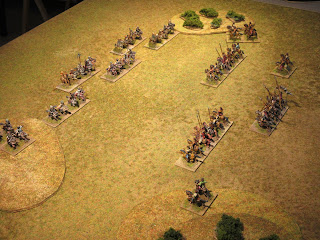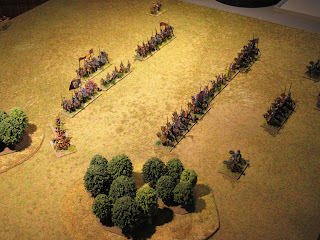The DBA3 army list for the Ancient British ends at 75 AD with their final pacification. However, during the brief expeditions beyond Hadrian’s Wall during the latter half of the 2nd century, the Brigantes revolted curtailing further conquests. Fuelled by the excellent Empire series by Anthony Riches, I added the Ancient British of the late 2nd century to the collection of Imperial Rome’s enemies. These lack chariots, but they are not mandatory and without them, the Ancient British have performed better than expected.
Two games
were played against Rome’s finest and the results can be read below. These games
complete the series; however, future battles are planned, some using the
collision course format or DBA24.
Game one
Rome found
the British arrayed in front of woods with its left anchored on a village. However,
to reach the enemy Rome would need to realign its front by bringing its right
wing forward.
The British caught Rome’s attention as they slowly approached the Roman line and hoped the infiltration of the wood on Rome’s left would go unnoticed. It did not, and Rome sent auxilia to secure the wood.
Both Roman wings floundered during the operation and sensing an opportunity, the barbarians struck.
The attack was ferocious, Rome losing two cohorts of legionnaires and artillery in the first rush. Casualties among the barbarian were light by comparison and the decision to retreat was made soon after the fall of a cohort of auxilia. Ancient British 4 - 1.
Game two
To meet
Rome for this battle, the British shortened their line. In contrast, Rome’s
line extended beyond the barbarian, but held its left flank back. As the
barbarians rushed forward, the Roman counter attack caught the British by
surprise.
At the first clash of arms, the British were able to reinforce their first line to confront the legionnaires. Casualties fell quickly on both sides as both centres and remaining flank came into contact. The pressure was greatest on Rome with the loss of its artillery and equites.
Regular formations on both sides become a shambles, but the advance of the cavalry was clearly to be seen by the barbarian. Led by their commander, the equites swung the battle in favour of Rome. Rome 4 – 3.
Observations
In game
one, the British made good use of high pip scores to infiltrate the wood and
reform their line in time to contact the legion. By turn four, the Ancient
British held the advantage, 3 – 1, they were now coasting home to a victory.
Game two
was a different story. Hard fought and quickly looking more a brawl than a
battle, the score came level at 3 – 3 at the end of turn three. This time, Roman
cavalry were in their element accounting for half the casualties inflicted on
the barbarians.
Early Imperial Roman
1 x General
(Cv), 1 x equites (Cv), 4 x legionnaires (4Bd), 3 x auxilia infantry (4Ax), 1 x
archers (Ps), 1 x light horse (LH), 1 x artillery (Art).
Ancient
British
1 x General (3Wb), 8 x warriors (3Wb), 2 x light horse (LH), 1 x skirmishers (Ps).
Romans in
Britain.org/British Tribes
Selgovae https://www.romanobritain.org/4-celt/clb_tribe_selgovae.php
Novantae https://www.romanobritain.org/4-celt/clb_tribe_novantae.php
Votadini https://www.romanobritain.org/4-celt/clb_tribe_votadini.php
















































